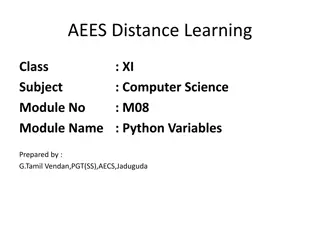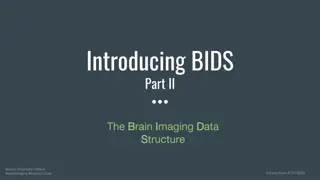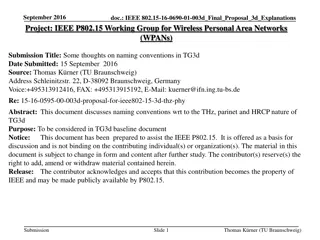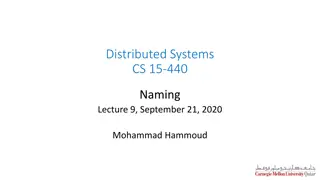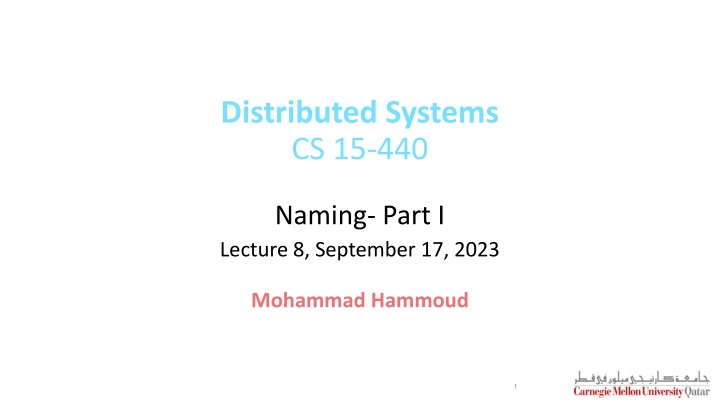
Naming in Distributed Systems
Today's lecture covered the importance of naming in distributed systems, where names are used to uniquely identify entities such as processes, remote objects, or newsgroups. The session discussed how names are mapped to entity locations through name resolution mechanisms like DNS lookup. Additionally, the concept of names, addresses, and identifiers was explored, emphasizing the significance of each in uniquely identifying entities in distributed environments. Examples from different courses highlighted naming conventions in both single-core and multi-core architectures.
Download Presentation

Please find below an Image/Link to download the presentation.
The content on the website is provided AS IS for your information and personal use only. It may not be sold, licensed, or shared on other websites without obtaining consent from the author. If you encounter any issues during the download, it is possible that the publisher has removed the file from their server.
You are allowed to download the files provided on this website for personal or commercial use, subject to the condition that they are used lawfully. All files are the property of their respective owners.
The content on the website is provided AS IS for your information and personal use only. It may not be sold, licensed, or shared on other websites without obtaining consent from the author.
E N D
Presentation Transcript
Distributed Systems CS 15-440 Naming- Part I Lecture 8, September 17, 2023 Mohammad Hammoud 1
Today Last Session: Architectures Today s Session: Naming (Chapter 5 in Steen s and Tanenbaum s book) Announcements: P1 design report is due today by midnight PS2 is due on Sep 26 Quiz I is on Sep 24
Course Map Applications Programming Models Fast & Reliable or Efficient DS Replication & Consistency Fault-tolerance Communication Paradigms Architectures Naming Synchronization Correct or Effective DS Networks
Course Map Applications Programming Models Replication & Consistency Fault-tolerance Communication Paradigms Architectures Naming Synchronization Networks
Naming Names are used to uniquely identify entities in distributed systems Entities may be processes, remote objects, newsgroups, etc., Names are mapped to entities locations using name resolution An example of name resolution: http://www.cdk5.net:8888/WebExamples/earth.html Name Resource ID (IP Address, Port, File Path) DNS Lookup 8888 WebExamples/earth.html 55.55.55.55 MAC address Host 02:60:8c:02:b0:5a
Names, Addresses, and Identifiers An entity can be identified by three types of references a) Name A name is a set of bits or characters that references an entity Names can be human-friendly (or not) b) Address Every entity resides on an access point, and the access point has an address Addresses may be location-dependent (or not) E.g., IP Address + Port c) Identifier Identifiers are names that uniquely identify entities A true identifier is a name with the following properties: An identifier refers to at-most one entity Each entity is referred to by at-most one identifier An identifier always refers to the same entity (i.e. it is never reused)
Naming as We Know it from 15-213: An Example Assuming a Single-Core Architecture Physical Address Tag Index Offset Cache Set 00 Set 01 Set 10 Set 11 10 Output
Naming as We Know it from 15-418: An Example Assuming a Multi-CoreArchitecture Physical Address Tag Index Home Offset 1000 Tiled Chip Multi-core Architecture Tile 8 Locate the block Locate the set Locate the value 0000 0001 0010 0011 L1 Cache 0100 0101 0110 0111 L2 Cache 1000 1001 1010 1011 Naming is about locating entities (e.g., cache blocks, data items, files, objects, processes, etc.,) After locating the home, naming continues the same way as in single-core architectures (assuming, physically distributed, logically shared L2 cache) 1100 1101 1110 1111 HomeDirectory
Naming Systems as We Will Learn them in 15-440 A naming system is a middleware that assists in name resolution Naming systems can be classified into three classes, based on the type of names used: a. Flat naming b. Structured naming c. Attribute-based naming
Classes of Naming Flat Structured Attribute-based
Flat Naming In flat naming, identifiers are simply random bits of strings (known as unstructured or flat names) A flat name does not contain any information on how to locate an entity We will study four types of name resolution mechanisms for flat names: 1. Broadcasting 2. Forwarding pointers 3. Home-based approaches 4. Distributed Hash Tables (DHTs)
1. Broadcasting Approach: Broadcast the name/address to the whole network; the entity associated with the name responds with its current identifier Example: Address Resolution Protocol (ARP) Resolve an IP address to a MAC address In this system, The IP address is the address of the entity The MAC address is the identifier of the access point Who has the address 192.168.0.1? Challenges: Not scalable in large networks This technique leads to flooding the network with broadcast messages Requires all entities to listen (or snoop) to all requests I am 192.168.0.1. My identifier is 02:AB:4A:3C:59:85
2. Forwarding Pointers Forwarding pointers enable locating mobile entities Mobile entities move from one access point to another When an entity moves from location A to location B, it leaves behind (at A) a reference to its new location at B Name resolution mechanism: Follow the chain of pointers to reach the entity Update the entity s reference when the present location is found Challenges: Long chains lead to longer resolution delays Long chains are prone to failures due to broken links
Forwarding Pointers An Example Stub-Scion Pair (SSP) chains implement remote invocations for mobile entities using forwarding pointers Server stub is referred to as Scion in the original paper Each forwarding pointer is implemented as a pair: (client stub, server stub) The server stub contains a local reference to the actual object or a local reference to another client stub When an object moves from A (e.g., P2) to B (e.g., P3), It leaves a client stub at A (i.e., P2) It installs a server stub at B (i.e., P3) Process P2 Process P1 Process P3 Process P4 = Remote Object; = Client stub n= Process n; = Caller Object; = Server stub;
3. Home-Based Approaches Each entity is assigned a home node The home node is typically static (has fixed access point and address) It keeps track of the current address of the entity Entity-home interaction: Entity s home address is registered at a naming service The entity updates the home about its current address (foreign address) whenever it moves Name resolution: The client contacts the home to obtain the foreign address Afterwards, the client contacts the entity at the foreign location
3. Home-Based Approaches An Example 1. Update home node about the foreign address Mobile entity Home node 3a. Home node forwards the message to the foreign address of the mobile entity 2. Client sends the packet to the mobile entity at its home node 3b. Home node replies to the client with the current IP address of the mobile entity 4. Client directly sends all subsequent packets directly to the foreign address of the mobile entity
3. Home-Based Approaches Challenges The static home address is permanent for an entity s lifetime If the entity moves permanently, a simple home-based approach incurs higher communication overhead Consider the scenario where the clients are nearer to the mobile entity than the home entity Caching the address of the entity at the clients sides can help, unless the entity moves very frequently How to handle invalid addresses? Replicating the address of the entity at a secondary server can help How to handle inconsistent addresses? Adopting a dynamic home for the entity can help (with or without replication) Secondary Server
4. Distributed Hash Table (DHT) DHT is a distributed system that provides a lookup service similar to a hash table (key, value) pairs are stored in the nodes participating in the DHT The responsibility for maintaining the mapping from keys to values is distributed among the nodes Any participating node can serve in retrieving the value for a given key We will study a representative DHT known as Chord DATA KEY DISTRIBUTED NETWORK Hash function Pink Panther ASDFADFAD Participating Nodes Hash function DGRAFEWRH cs.qatar.cmu.edu Hash function 86.56.87.93 4PINL3LK4DF
Node n (node with id=n) Entity with k Chord 000 Chord assigns an m-bit identifier (randomly chosen) to each node A node can be contacted through its network address 003 Node 000 004 008 Node 005 Furthermore, it maps each entity to a node Entities can be processes, files, etc., 040 079 Node 010 Mapping of entities to nodes Each node is responsible for a set of entities An entity with key k falls under the jurisdiction of the node with the smallest identifier id >= k. This node is known as the successor of k, and is denoted as succ(k) Node 301 Map each entity with key k to node succ(k)
A Nave Key Resolution Algorithm The main objective in DHT is to efficiently resolve a key k to the network location of succ(k) Given an entity with key k, how to find the node succ(k)? 19 00 31 01 1. All nodes are arranged in a logical ring according to their IDs 2. Each node p keeps track of its immediate neighbors: succ(p) and pred(p) 3. If p receives a request to resolve key k : If pred(p) < k <=p, node p will handle it Else it will forward it to succ(n) or pred(n) 30 02 29 03 28 04 27 05 26 06 25 07 24 08 23 09 22 10 Solution is not scalable: As the network grows, forwarding delays increase Key resolution has a time complexity of O(n) 21 11 20 12 19 13 18 14 17 15 16 = Active node with id=n = No node assigned to key p n p
Key Resolution in Chord 1 04 2 04 Chord improves key resolution by reducing the time complexity to O(log n) 1. All nodes are arranged in a logical ring according to their IDs 3 09 4 09 1 01 1 09 5 18 2 01 2 09 3 01 00 3 09 31 01 4 04 30 02 2. Each node p keeps a table FTp of at-most m entries. This table is called Finger Table FTp[i] = succ(p + 2(i-1)) NOTE: FTp[i] increases exponentially 26 4 14 29 03 5 14 5 20 28 04 27 05 26 06 25 07 1 11 3. If node p receives a request to resolve key k : Node p will forward it to node q with index j in Fp where q = FTp[j] <= k < FTp[j+1] If k > FTp[m], then node p will forward it to FTp[m] If k < FTp[1], then node p will forward it to FTp[1] 1 28 24 08 2 11 2 28 3 14 23 09 3 28 4 18 4 01 5 28 22 10 5 09 21 11 1 14 20 12 2 14 19 13 1 21 3 18 18 14 17 15 2 28 16 4 20 1 18 1 20 3 28 5 28 2 18 2 20 4 28 3 18 3 28 5 04 4 28 4 28 5 01 5 04
Chord The Join and Leave Protocol In large-scale distributed Systems, nodes dynamically join and leave (voluntarily or due to failures) 00 31 01 30 02 29 03 28 04 27 05 Node 4 is succ(2+1) 26 06 If a node p wants to join: It contacts an arbitrary node, looks up for succ(p+1), and inserts itself into the ring 25 07 24 08 02 Who is succ(2+1) ? 23 09 22 10 If node p wants to leave: It contacts pred(p)and succ(p+1)and updates them 21 11 20 12 19 13 18 14 17 15 16
Chord The Finger Table Update Protocol For any node q, FTq[1] should be up-to-date It refers to the next node in the ring Protocol: Periodically, request succ(q+1) to return pred(succ(q+1)) If q = pred(succ(q+1)), then information is up-to-date Otherwise, a new node p has been added to the ring such that q < p < succ(q+1) FTq[1] = p Request p to update pred(p) = q Similarly, node p updates each entry i by finding succ(p + 2(i-1))
Exploiting Network Proximity in Chord The logical organization of nodes in the overlay network may lead to inefficient message transfers Node k and node succ(k +1) may be far apart Chord can be optimized by considering the network location of nodes 1.Topology-Aware Node Assignment Two nearby nodes get identifiers that are close to each other 2.Proximity Routing Each node qmaintains r successors for ith entry in the finger table FTq[i] now refers to r successor nodes in the range [p + 2(i-1), p + 2i -1] To forward the lookup request, pick one of the r successors closest to the node q
Next Lecture Structured and attribute-based namings








